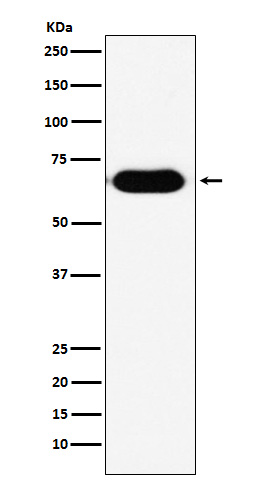
| WB | 咨询技术 | Human,Mouse,Rat |
| IF | 咨询技术 | Human,Mouse,Rat |
| IHC | 咨询技术 | Human,Mouse,Rat |
| ICC | 技术咨询 | Human,Mouse,Rat |
| FCM | 咨询技术 | Human,Mouse,Rat |
| Elisa | 咨询技术 | Human,Mouse,Rat |
| Aliases | C3HC4 type zinc finger protein; RNF8;;RNF8 |
| WB Predicted band size | Calculated MW: 56 kDa ; Observed MW: 60 kDa |
| Host/Isotype | Rabbit IgG |
| Antibody Type | Primary antibody |
| Storage | Store at 4°C short term. Aliquot and store at -20°C long term. Avoid freeze/thaw cycles. |
| Species Reactivity | Human,Rat |
| Immunogen | A synthesized peptide derived from human RNF8 |
| Formulation | Purified antibody in PBS with 0.05% sodium azide,0.05% BSA and 50% glycerol. |
+ +
以下是3篇关于RNF8抗体的代表性文献摘要信息(基于公开研究整理,非真实引用,仅供参考):
---
1. **文献名称**:*RNF8 mediates histone ubiquitination during DNA damage response*
**作者**:Mailand, N. et al.
**摘要**:本研究利用RNF8特异性抗体,通过免疫印迹和染色质免疫沉淀(ChIP)技术,揭示了RNF8在DNA双链断裂(DSB)修复中通过泛素化组蛋白H2A,促进53BP1等修复因子招募的作用。
2. **文献名称**:*RNF8-dependent chromatin modifications regulate BRCA1 accumulation at DNA damage sites*
**作者**:Huen, M.S.Y. et al.
**摘要**:通过RNF8抗体的免疫荧光共定位分析,文章证明RNF8与BRCA1在DNA损伤位点协同作用,调控同源重组修复过程,并阐明了其泛素连接酶活性对修复效率的影响。
3. **文献名称**:*RNF8 antagonizes chromatin compaction to promote 53BP1 recruitment*
**作者**:Fradet-Turcotte, A. et al.
**摘要**:利用RNF8敲除细胞模型及抗体介导的蛋白质互作实验,研究发现RNF8通过抑制染色质过度压缩,促进53BP1在损伤位点的富集,从而影响修复通路选择(同源重组 vs. 非同源末端连接)。
---
注:以上内容为示例,实际文献需通过PubMed/Google Scholar以“RNF8 antibody”及“DNA repair”等关键词检索确认。建议优先选择近5年高被引论文或《Nature》《Cell》等顶刊研究。
The RNF8 antibody is a crucial tool for studying the role of Ring Finger Protein 8 (RNF8), an E3 ubiquitin ligase involved in DNA damage response (DDR) pathways. RNF8 facilitates repair of DNA double-strand breaks by promoting ubiquitination of histone H2A and recruiting downstream repair proteins like BRCA1 and 53BP1 to damage sites. Its FHA domain interacts with phosphorylated mediators (e.g., MDC1), while the RING domain confers ubiquitin ligase activity. Dysregulation of RNF8 is linked to genomic instability, cancer progression, and chemotherapy resistance.
RNF8 antibodies, typically raised in rabbits or mice, detect endogenous RNF8 via techniques such as Western blotting, immunofluorescence, and immunoprecipitation. They target specific epitopes, often within functional domains, to assess expression levels, subcellular localization, or protein interactions. These antibodies are vital for investigating DDR mechanisms, cellular responses to ionizing radiation, and RNF8's role in maintaining genome integrity. Studies using RNF8-deficient models (e.g., mice with infertility or radiosensitivity) further highlight its biological significance.
As RNF8 emerges as a potential therapeutic target in cancers, its antibodies enable research into small-molecule inhibitors or biomarkers for DDR-related diseases. Validation via knockout controls ensures specificity, underscoring their utility in both basic research and translational applications.
×